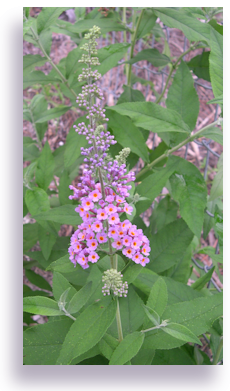 Buddlelia is a great naturalizing shrubby bush for many gardeners. Loved by butterflies, hover flies, bees and other beneficial insects, as well as hummingbirds; this plant continues to bloom from spring through fall, and the fragrance is delicious.
Buddlelia is a great naturalizing shrubby bush for many gardeners. Loved by butterflies, hover flies, bees and other beneficial insects, as well as hummingbirds; this plant continues to bloom from spring through fall, and the fragrance is delicious.
Depending upon the cultivar, the butterfly bush can grow anywhere from 5 feet tall to 15 feet tall. The long panicles of purple, blue, yellow, white and even multicolored blooms are well known for attracting butterflies, hence the common name.
The Butterfly bush is a great northern as well as southern grower. As long as your winter temperatures do not dip below 20°, butterfly bush will reamin green year round. There are a few exceptions, and these can be grown in hardiness zones 8 and south. These cultivars include buddlelia crispi and buddleia asiatica.
The flower panicles are grown in sets of three, from one main stem. They each will ripen and bloom at different times.
Buddlelia is sometimes gangly in it's growth habit, and needs to be pruned regularly to keep it in shape. Removing the panicles after they have bloomed will encourage new flowering growth. Pruning of Butterfly bush is important, as they will only flower on new wood.
When ready to plant out in your lawn, give buddlelia a sunny spot with good draining soil that has some added loam. The soil does not have to be rich, but giving it a good boost is helpful to getting it established. The roots become bulbous as they age, and head deeper into the soil. If placed out about 6 feet apart, they will form a hedge of sorts in about 2 years.
In frigid winter zones 5 and 6, the stems will completely die to ground level over the course of a winter. Cutting them off at this level is good, do it before you expect spring growth, or after the first good, heavy frost. The plant will rebound in spring, and the bigger the root ball becomes, the faster and larger it will regrow that spring into fall.
Propagation of Butterfly bush is by semi∼woody cuttings, placed in peat cups and night time temperatures do not go below 75° and daytime not over 80°. Then you will have a good chance of getting them to root, usually within 4 to 6 weeks. Keep the few leaves you left on the stems misted with kelp water, or cover with a plastic dome. If you use a dome, be sure the temperature does not build up, or you will lose the cuttings to mildew and rot.
Fertilize Butterfly bush in early spring with a regular fertilizer. Do not make the mistake of over fertilizing it though, as all it seems to produce is a lot of leaf growth and less flowering panicles.
If you do it all correctly, your Butterfly bushes will thrive year after year. Note that in some places, it has even become invasive, so check with your local agricultural extension office for more on this before planting it out. If all is well, you will love the intoxicating fragrance and flowers, and the never ending parade of butterflies and hummers it attracts.
Tags: buddleia, butterfly bush,, buddleia, butterfly bush, care of butterfly bush,


